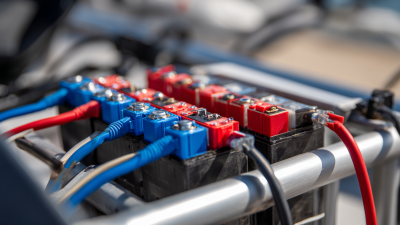The Ultimate Guide to Understanding Deep Cycle Batteries: Powering Your Adventures
Deep Cycle Batteries are essential components in a variety of applications, from powering electric vehicles to supporting renewable energy systems. According to a report by Fortune Business Insights, the global deep cycle battery market is projected to reach $13.12 billion by 2028, growing at a compound annual growth rate (CAGR) of 8.7% from 2021. This growth is driven by the increasing demand for energy storage solutions and the rise of off-grid applications.

Unlike traditional batteries, deep cycle batteries are designed to discharge a significant portion of their capacity, making them ideal for applications that require prolonged power supply. Their unique construction allows for deep discharges and recharges, thus providing reliability and longevity in power management.
Understanding the intricacies of deep cycle batteries is vital for adventurers and those engaged in outdoor activities, where a reliable power source can enhance the overall experience.
Understanding Deep Cycle Batteries: Key Features and Benefits
Deep cycle batteries are essential components in various applications, from recreational vehicles (RVs) to renewable energy systems. Unlike traditional batteries, they are designed to be discharged and recharged repeatedly, making them ideal for powering devices over prolonged periods. According to a report by the Battery Council International, the global market for deep cycle batteries is projected to reach $25 billion by 2026, illustrating their growing importance in both consumer and industrial sectors.

Key features of deep cycle batteries include their ability to withstand deep discharges without significant damage, typically providing a usable capacity of around 50-80% of their total storage. This is in stark contrast to starting batteries, which are designed for short bursts of energy. Furthermore, deep cycle batteries offer various chemistries—lead-acid, lithium-ion, and more—that affect their efficiency and longevity.
For example, lithium-ion deep cycle batteries have a significantly longer lifespan of up to 10,000 cycles compared to lead-acid variants, which generally last between 500 to 1,500 cycles, according to the National Renewable Energy Laboratory. This versatility and durability make deep cycle batteries an excellent investment for those looking to power their adventures sustainably.
Types of Deep Cycle Batteries: Choosing the Right One for Your Needs
When it comes to deep cycle batteries, understanding the different types available is essential for choosing the right one for your needs. These batteries are specifically designed to be discharged and recharged repeatedly, making them ideal for applications like RVs, boats, and renewable energy systems. The two most common types are flooded lead-acid batteries and sealed batteries. Flooded batteries are usually more affordable and offer a longer lifespan, but they require regular maintenance. On the other hand, sealed batteries, including absorbed glass mat (AGM) and gel cell varieties, are maintenance-free and can be installed in any position, though they tend to come at a higher price point.

Tips for selecting the right deep cycle battery include evaluating your power requirements based on your typical usage. Calculate watt-hours needed daily and choose a battery that can deliver that power reliably without deep discharges, as this can significantly reduce battery life. Pay attention to the battery's amp-hour (Ah) rating; a higher Ah rating indicates a longer operational duration. Additionally, consider the charging method that suits your setup best, as some batteries recharge faster than others, which is crucial for ensuring your adventures remain uninterrupted.
How to Properly Maintain and Care for Your Deep Cycle Battery
Proper maintenance of your deep cycle battery
is essential for ensuring its longevity and optimal performance. Start by regularly checking the water levels if you have a flooded lead-acid battery. Always ensure that the plates are covered with electrolyte, as low levels can cause damage. If you notice any corrosion around the terminals, clean them with a mixture of baking soda and water to prevent connectivity issues.
To maximize the efficiency of your battery, it’s crucial to avoid deep discharges. Aim to recharge your battery when it reaches about 50% capacity. This practice helps to prolong its life and maintains its ability to hold a charge. Additionally, using a smart charger can help in managing the charging process and avoid overcharging, which can be harmful.
Lastly, consider temperature effects on battery performance. Deep cycle batteries can be sensitive to extreme temperatures. Keeping your battery in a controlled environment can help mitigate these risks. Cold temperatures can reduce capacity, while excessive heat can lead to accelerated wear. Investing in a battery monitor can also provide you with real-time information about your battery’s health and status.
Maximizing Battery Life: Tips for Efficient Usage and Charging
When it comes to maximizing the lifespan and efficiency of deep cycle batteries, understanding the right usage and charging techniques is crucial. A well-maintained deep cycle battery can last up to 1,500 charge cycles, especially within environments that prevent overheating. Keeping batteries in a cool, dry space not only enhances performance but also extends their life significantly. This principle is akin to smartphone care; just as reducing screen brightness can save battery life on your device, regulating the operating temperature of your battery can ensure optimal performance.
To further optimize your battery's lifespan, consider adopting good charging habits. Avoid letting your battery discharge completely before recharging; doing so can shorten its overall lifespan. Instead, aim to recharge once the battery level drops to around 20%. Additionally, utilizing smart charging modes—similar to those used by modern smartphones—can help prevent overcharging, which is known to cause long-term damage. Always check the manufacturer's recommendations for charging and storage to get the best out of your power source and keep your adventures powered for longer.
The Ultimate Guide to Understanding Deep Cycle Batteries: Powering Your Adventures - Maximizing Battery Life: Tips for Efficient Usage and Charging
| Battery Type | Capacity (Ah) | Voltage (V) | Cycle Life | Recommended Usage |
|---|---|---|---|---|
| Flooded Lead Acid | 100 | 12 | 300-500 | RV, Trolling Motor |
| AGM (Absorbent Glass Mat) | 120 | 12 | 500-1200 | Solar Power Systems |
| Lithium-Ion | 100 | 12 | 2000-5000 | Electric Vehicles, Off-Grid Systems |
| Gel | 80 | 12 | 500-1000 | Marine, Golf Carts |
Troubleshooting Common Deep Cycle Battery Issues and Solutions
When it comes to deep cycle batteries, understanding common issues and effective troubleshooting techniques is essential for ensuring optimal performance. One prevalent problem is a reduced capacity, which can stem from sulfation or failure to equalize the battery. Regular maintenance, such as cleaning terminals and checking water levels, can help prevent these issues. According to industry reports, improper maintenance can reduce battery life by up to 50%. Implementing routine checks ensures longevity and reliability during adventures.
Another common issue is inefficient charging. Users often find their batteries draining faster than expected, particularly due to poor charging practices. With advancements in battery technology, utilizing smart chargers can optimize charge cycles and reduce the time spent charging by approximately 30%, according to recent findings.
Tips: Always match the charger specifications to the battery requirements and avoid leaving the battery in a discharged state for extended periods, as this can lead to irreversible damage.
Related Posts
-

Solutions for Finding the Best Deep Cycle Batteries for Reliable Energy Storage Globally
-

What Makes the Best Deep Cycle Car Battery Stand Out in Performance
-

Finding Reliable Suppliers for the Best Deep Cycle Boat Battery Made Easy
-

How to Maximize the Lifespan of Your Deep Cycle Car Battery: Proven Tips and Industry Insights
-

Exploring the Surge in Global Demand for Deep Cycle Boat Batteries at the 137th Canton Fair
-

Exploring Market Trends for Car Battery Stores at the 138th Canton Fair 2025
